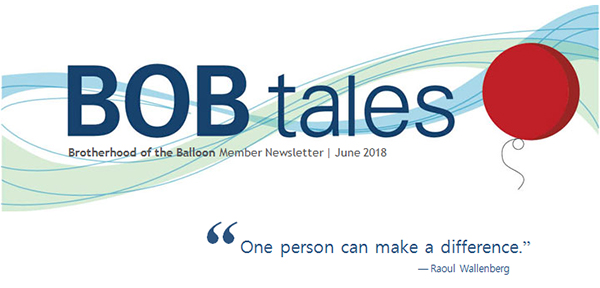
Dear Members:
It’s hard to believe that my daughter, Deb, has been working with me for more than eight years. And what a blessing she’s been!
When I started this “ministry” in December 2000, we were six guys from different parts of the country—all technically oriented—who wanted to keep in touch, share information on our PSA results after treatment, and compare notes on any side effects we might be experiencing. We also wanted to stay connected with this extraordinary technology called proton therapy that we all chose to treat our prostate cancer.
I started issuing a monthly newsletter at the very beginning and I remember clearly how much work it was to put the BOB Tales together. It was often 10-12 pages and covered topics like growth in our membership, testimonials, featured member-of-the-month, stories about how our members were helping others discover proton therapy, new developments in proton therapy, improvements in prostate cancer diagnostics, health tips, cancer prevention, our new website, and I always included something “schmaltzy” at the end to make members smile or just feel good.
Putting a “Contact Us” link on our website and including my email address at the back of my book was a blessing and a curse. It motivated newly diagnosed men to take the initiative to learn more about a relatively unknown treatment option—one that might not only destroy their cancer but leave them with an excellent quality of life after treatment. The curse part was the growing number of phone calls and emails, from a few dozen a month initially, to hundreds. I was going under, and completely unable to keep up with the tidal wave of work.
Then Deb came along.
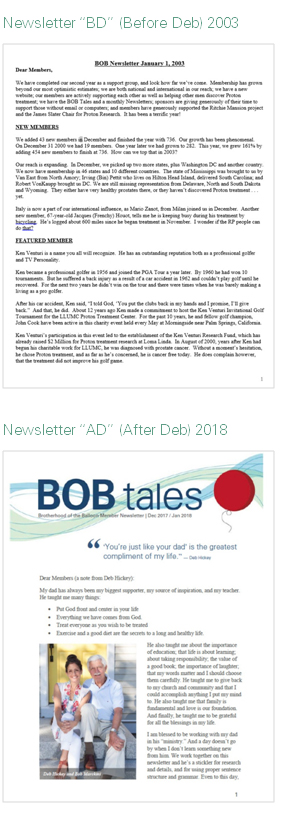 It wasn’t easy for me to persuade her to join me. She said, “Your support group is all about men and prostate cancer. I’m a female and I know nothing about this subject. How could I possibly help?”
It wasn’t easy for me to persuade her to join me. She said, “Your support group is all about men and prostate cancer. I’m a female and I know nothing about this subject. How could I possibly help?”
I had one thing going for me in this debate. Deb’s company was running out of space and they were moving from a suburb close to Deb’s home to downtown Boston, a nightmare of a commute for her, and just at the time she and her husband were adopting a baby. If she joined me, she could work out of her home. I waited for the right time to play this card.
Deb was a psychology major in college with post graduate education in graphic design. At the time we began discussing her joining me, she was director of marketing for the first and largest search engine marketing firm in the world. She was also smart, articulate and resourceful, as well as a person people loved being around. “You’re perfect for the job,” I said. “Your education, personality, communication skills, and work experience will be helpful in our mission and, in time you’ll learn what you need to know about prostate cancer and proton therapy.”
I was so right.
Through my “excellent” skills of communication and persuasion—plus a little begging—I persuaded Deb to join me.
Today, she is probably one of the most knowledgeable, non-medical people I know—male or female—on the subject of prostate cancer in general, and proton therapy in particular.
Since joining me, she has re-designed and reformatted our newsletter, edited and re-launched our website, updated our PowerPoint presentation, established a Facebook page and blog, and expanded our patient reference lists. She handles 95 percent of the inquiries that come in through our social portals, as well as most of the phone calls. Our members love her, and she loves what she’s doing.
Last month Deb traveled to Scottsdale, AZ to represent the BOB and our 10,000 members at the annual National Association for Proton Therapy Conference. Surrounded by more than 250 medical and administrative professionals—the elite of the proton world—Deb was on a panel and spoke on the subject of proton therapy advocacy. Her summary of some of the events from the conference is in this issue of BOB Tales.
Who knew back in 2000 when six guys got together to form the Brotherhood of the Balloon, we’d grow to 10,000 members from all 50 U.S. states and 39 countries and become a major force in the proton movement. This would not have happened without Deb Hickey.
All I can say is, thank God for Deb.
Our news feature this month is on a negative article on proton therapy in The New York Times. We received so many inquiries about this from members we thought we would write about it. A link is provided to the article and we have attempted to put the story in proper perspective.
We are also covering, in some detail, a battle under way in Tennessee involving a bill that would allow some insurance coverage for proton therapy. With full support of the Tennessee House and Senate, they still face a major obstacle to the bill’s passing.
Finally, June is a special month in some ways: June 3 is National Cancer Survivor’s day and we can all relate to that. The week of June 11 is National Men’s Health week, a subject near and dear to our hearts: Every BOB Tales provides important information on maintaining and improving member’s health. And June 17 is Father’s Day. Most of us are fathers and because we chose proton therapy for our prostate cancer, we hope to be around to spend many more years with our children and grandchildren. So … Happy National Cancer Survivor’s Day, Happy National Men’s Health Week, and Happy Father’s Day to our members!
We have another packed BOB Tales newsletter with a little something for everyone, including the NAPT Conference review, a new proton center opening, a number of important health tips and a great brain teaser.
As always, we hope you enjoy the May issue of BOB Tales and we welcome your feedback.
Bob Marckini
To print the BOB Tales newsletter or view the newsletter with a larger font size, click here for the PDF file.
In this Issue:
- Negative Article on Proton
- Breaking News: Tennessee Proton Therapy Bill
- The Importance of Support When Battling Cancer
- Call for Urologists
- Recap: NAPT Conference 2018

Negative Article on Proton
There’s an old saying about journalism, “If it bleeds, it leads.” News is a money making industry, and according to Shutterstock, it’s an industry that “doesn’t always make the goal to report the facts accurately.” Watching and reading the news, according to this source “can be a psychologically risky pursuit, which could undermine your mental and physical health.”
Much of the news we watch and read today is fear-based sensationalism. Its aim is to grab the viewer’s attention. Such was the case with a recent New York Times article titled, For Cancer Centers, Proton Therapy’s Promise Is Undercut by Lagging Demand. The article was published last month. It then was picked up by a number of news outlets and received a lot of exposure.
It didn’t take long for Deb and Bob’s inboxes to get flooded with emails from angry members all over the world. Here is a sampling of comments we received:
- “This is outrageous!”
- “It’s simply not true.”
- “My results were outstanding.”
- “My cancer was cured and no side effects. My friends who had surgery or conventional radiation have a very different story to tell.”
- “This guy doesn’t know what he’s talking about.”
- “How can they print this stuff?”
The author did acknowledge that proton therapy was a superior technology “for treating tumors in delicate areas where surgery was not an option—near the eye, for example—and in children, it remains the best choice,” he wrote. But the theme of the article was that proton therapy hasn’t been proven to be worth the higher cost for treating common cancers such as prostate and breast cancer; there is too much proton capacity and there aren’t enough patients for the number of proton centers that have already been built.
The author chose to quote—as an authority on this subject—oncologist Dr. Ezekiel Emanuel, former policy adviser to President Obama and one of the architects of the Affordable Care Act. Dr. Emanuel is a controversial figure with interesting views on euthanasia and wasteful medical spending on elderly people. He has vowed, personally, to “cease accepting medical interventions” at age 75 according to the Los Angeles Times. This means “No colonoscopies, no cancer screening, no cardiac tests. Not even antibiotics or flu shots.” Dr Emanuel also has a history of being negative on proton therapy.
It certainly would have been a more balanced article if the author had spoken with any one of the many brilliant medical professionals in the proton world. But that might not have served the author’s purpose or objective.
Like much news we read or hear in the media, there are elements of truth, but the perspective has been manipulated for sensationalism using such commentary as “medical arms race” and “the industry is littered with financial failure.” So much of the story is out of context, and parts are simply not true. For example, the Indiana proton facility did not close because of lack of patients; it closed for other reasons which we have covered in past BOB Tales.
The fact is, fewer than one percent of patients receiving radiation therapy are receiving proton therapy. Many physicians believe that upwards of 50 percent of patients treated with radiation would have better results with proton therapy. That means the market for proton therapy is at least 50 times larger. And with advances in proton therapy resulting from current and planned research, there’s little doubt the proton market will be much larger in the future. So, lagging demand isn’t the issue.
One can’t help but wonder if the author is correct, and proton therapy is in so much financial difficulty, why then is there an explosion in the number of proton centers around the world? When Bob Marckini was treated in 2000, there was one proton center in southern California at Loma Linda University Cancer Center. Today there are 28 in the U.S. and 41 proton centers in other countries. Hardly a month goes by when a new proton center announcement is made. Why would 69 institutions worldwide invest millions and millions of dollars in proton therapy if it’s an unproven technology without patient volume? And those investments continue.
Are there some difficulties at this stage of the evolution of proton therapy? Absolutely. But the issues are being dealt with; the technology is developing and expanding; and most important, patients are being cured and are being given the best opportunity for preserving the quality of their lives.
The biggest obstacle, from our perspective, is private insurance coverage. But with research under way on technologies such as hypo-fractionation and proton SBRT along with clinical trials, such as PARTIQoL and COMPPARE, the insurance issue will be resolved in due time.
In the meantime, we encourage you to take all the news you read, hear, and see on just about any subject, with a few grains of salt. Remember, “If it bleeds, it leads.”
Tennessee Proton Therapy Bill
After nearly five years in the works, the Tennessee State House and Senate recently voted to pass a bill to improve coverage of proton therapy for the insurance plans provided by the state. The Cancer Patient Choice Act would require the state of Tennessee insurance plans to cover hypofractionated proton therapy for any members who would otherwise have been approved to receive IMRT by a board-certified radiation oncologist.
Tennessee insurance plans cover over 276,000 lives. Supporters of the bill expected over 100 Tennessee employees (and family members) per year to benefit by having access to proton therapy. Tom Welch, president of Provision CARES Proton Therapy Center in Knoxville, said, “Not only does this bill establish coverage for Tennessee employees, it also establishes a precedent for other employers to also cover proton therapy.”
Those in support of the bill were hopeful Tennessee Gov. Bill Haslam would sign it earlier this month. The process has been lengthy, and since they had passed many key legislative steps, they were confident the governor would approve the bill.
Governor Vetoes Bill
 Early this month, Gov. Haslam vetoed legislation that would have required state employee insurance to cover proton therapy. He argued the bill would burden patients with excessive charges from out-of-network providers.
Early this month, Gov. Haslam vetoed legislation that would have required state employee insurance to cover proton therapy. He argued the bill would burden patients with excessive charges from out-of-network providers.
“The provider advocating this bill rejected a medically appropriate plan for expanded coverage to instead pursue a political mandate,” Haslam said in a statement. “The state is committed to high-quality care that is medically appropriate and fiscally responsible for patients and taxpayers, but this mandate could put patients at risk and expose them to excessive charges from out-of-network providers.”
Sponsors of the bill, Sen. Mark Green and Rep. Bob Ramsey, have called for a special meeting to consider overriding the veto, a move supported by Executive Director Scott Warwick of the National Association for Proton Therapy. Warwick stated, “His statement that the bill could ‘put patients at risk and expose them to excessive charges from out-of-network providers’ is incorrect and misguided. The bill’s language, which improves access for cancer patients on the state health plan who would benefit from hypofractionated proton therapy, explicitly states that there will be no additional cost over standard IMRT to the patient, the state, or its insurers…”
Special Session to Override Possible
There may be hope for Tennesseans who seek proton treatment; there’s talk of a possible special session to override Haslam’s veto.
In a statement, Haslam specifically opposed the mandate language in the bill saying, “The state plan covers many forms of radiation treatment.”
Several private insurers cover at least part of the cost of proton therapy, as does Medicaid and Medicare.
“I have only concluded that he has bowed to the wills of the insurance lobby,” said Tom Welch. “The Speaker of the House and Lt. Gov. Randy McNally could call a special veto override session.”
Rep. Bob Ramsey said the plan is to wait to see what other bills the governor may veto before calling a special session.
BOB Member Fights Back
 Since Don Denton’s successful proton treatment in 2011, he’s been a strong advocate for proton therapy in his home state of Tennessee. A few years ago, he launched the Tennessee Cancer Patient Coalition to educate others about proton therapy and “serve as an advocate for cancer patients and their caregivers.” The day of the veto, Denton changed the website’s home page to catch visitors’ attention and give them a straight path to contact legislators to call for a special session to override Gov. Haslam’s veto. Denton also links to his lengthy response to the veto on the home page.
Since Don Denton’s successful proton treatment in 2011, he’s been a strong advocate for proton therapy in his home state of Tennessee. A few years ago, he launched the Tennessee Cancer Patient Coalition to educate others about proton therapy and “serve as an advocate for cancer patients and their caregivers.” The day of the veto, Denton changed the website’s home page to catch visitors’ attention and give them a straight path to contact legislators to call for a special session to override Gov. Haslam’s veto. Denton also links to his lengthy response to the veto on the home page.
Stay tuned. For immediate updates on this story, be sure to “like” our Facebook page.

We’ve been producing BOB Tales newsletters monthly for more than 17 years. During this time there have been important articles that many new members haven’t seen, and some long-time members may have forgotten. So, we decided to periodically re-run some articles from past newsletters. The following is from August 2004.
The Importance of Support When Battling Cancer
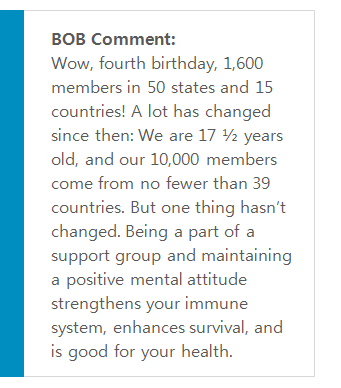 The Brotherhood of the Balloon is approaching its fourth birthday. And little did we know back in 2000 that we would someday become an international support group with more than 1,600 members in 50 states and 15 countries. I remember wanting to stay in touch with those men I met while in treatment to compare notes on PSA progress, side effects, and other things.
The Brotherhood of the Balloon is approaching its fourth birthday. And little did we know back in 2000 that we would someday become an international support group with more than 1,600 members in 50 states and 15 countries. I remember wanting to stay in touch with those men I met while in treatment to compare notes on PSA progress, side effects, and other things.
I have since learned that support groups provide far more important services than information sharing. A study by the American Cancer Society has concluded that “being part of a support group following cancer treatment improves quality of life and enhances patient survival.” Also, “Most oncologists agree that positive mental attitude plays a major role in the recovery from cancer.” I suspect that’s because it has been scientifically proven that a positive mental attitude strengthens the immune system and our immune system helps fight off cancers that attempt to invade our bodies. So, participating in a support group like the BOB can be good for your health!

Call for Urologists
We routinely receive requests for the names of urologists who understand and support proton therapy for prostate cancer. Our reference list titled, “Member Recommended Urologists,” contains 85 urologists from 31 U.S. states. The states with no recommended urologists include: Alabama, Alaska, Connecticut, Delaware, Kansas, Kentucky, Louisiana, Maine, Massachusetts, Mississippi, Nebraska, New Hampshire, New Mexico, North Dakota, Rhode Island, South Dakota, Vermont, West Virginia, and Wisconsin.
If you know of a urologist who is knowledgeable about proton therapy and/or supportive of your proton treatment decision, we would like to hear from you, especially if he/she is from one of the above mentioned states. Please send an email to [email protected].
Also, some of the urologists on our list may have moved on or retired. If you recommended a urologist in the past who no longer practices, please let us know so we may keep our list up-to-date.

Brothers-in-law and the Blog
We’ve written about BOB member Jim Tuggey many times. Jim, a retired U.S. Army colonel, was treated with proton therapy for his prostate cancer in 1999. He was so thankful for his treatment, he launched a blog in 2004 to promote proton therapy and share his personal experiences and opinions on the treatment for the following 10 years. The blog was robust with content on prostate cancer and proton therapy and subsequently achieved great visibility within the major search engines and even won a few awards.
Jim also became a financial supporter of proton therapy research and the BOB, and a good friend of Bob Marckini.
For the past few years, Jim’s health has been declining and he’s been unable to keep up with his blog. Fortunately, his nephew carried on Jim’s work and updated the blog periodically for a few years, and has since turned it over to the BOB. We’re thrilled to carry the torch and excited about our first post about another of Jim’s family members, his brother-in-law, Floyd Jordan. Floyd also happens to be a BOB member, treated for his prostate cancer in August, 2012.
 We recently reached out to Floyd and his wife, Judy, after they made a contribution to proton research via the Marckini Chair at Loma Linda University Cancer Center. Floyd was thankful we contacted him and gave us an update on his “very successful proton treatment.”
We recently reached out to Floyd and his wife, Judy, after they made a contribution to proton research via the Marckini Chair at Loma Linda University Cancer Center. Floyd was thankful we contacted him and gave us an update on his “very successful proton treatment.”
When his brother-in-law, Jim, was diagnosed, he was advised by his physician to “run, don’t walk” to Loma Linda for proton therapy. Jim didn’t waste any time—he set up a consultation and was quickly admitted for treatment. When he was finished, Jim told anyone who would listen about his treatment experience and outcome. One of those people was Floyd.
Thirteen years later, Floyd was diagnosed with prostate cancer. He remembered his brother-in-law’s story and read his blog over the years. This made his treatment decision easy.
“Since my proton treatment ended, my PSA readings have been low and my activity level has been high,” Floyd said. Floyd loves to fish, travel, do wood working, and serve others. He appreciates life and considers each day a blessing. Floyd follows in his brother-in-laws footsteps spreading the word about proton therapy to others. “It has been wonderful to share my story of proton therapy,” Floyd said. “With Bob’s book and the monthly newsletter, I’ve had a lot of help convincing others to have protons.” Floyd also told us, “It’s a pleasure for my wife, Judy, and me to financially support Loma Linda and proton therapy research.”
How to Give to Proton Therapy Research
- Donate online: Visit the LLUCC website.
- Send a check: Make it out to: “LLUCC Proton” with “Marckini Chair” on the memo line. Mail to: LLUH, Office of Philanthropy, P.O. Box 2000, Loma Linda, CA 92354.
- Make a call: Call Elvia DeHaro at 909-558-5010.
How to Give to Vision 2020
- Donate online: Visit the LLUH website.
- Send a check: Make it out to: “LLUH Vision 2020.” Mail to: LLUH, Office of Philanthropy, P.O. Box 2000, Loma Linda, CA 92354.
- Make a call: Call 909-651-2020.
How to Make a Future Gift
- Make a future gift: Contact Todd Mekelburg at the Office of Planned Giving at Loma Linda University Health at 909-558-5376 or [email protected].
- Other ways to give: Contact Matt Miller at the Office of Philanthropy at Loma Linda University Health at 909-558-3582 or [email protected].
.jpg)
Recap: NAPT Conference 2018
The sixth annual National Association for Proton Therapy Conference was held at the Scottsdale Resort at McCormick Ranch in Scottsdale, AZ March 25 through 28. This year’s event title was proving Access through Education, Awareness and Outcomes.
The event was attended by proton center clinical and administrative leaders representing almost all proton centers in the U.S. and some overseas. Additional attendees included representatives of hospitals and medical centers who are either building proton centers or considering building proton centers. Also in attendance were vendors who design and make equipment, products, and systems that support proton therapy and related technologies.
The planning committee did an excellent job choosing timely topics for the proton community. This year’s conference consisted of numerous panels, presentations and testimonies as well as
an exhibit hall with 25 displays highlighting the latest in proton treatment center design, patient tracking software, and medical devices used to enhance treatment and minimize side effects from treatment. There were close to 260 in attendance at this year’s conference, a new record.
As mentioned in last month’s issue, Deb Hickey was asked by NAPT to speak on the panel, Advocating for Proton Therapy. Following is a recap of Deb’s presentation, along with highlights from the conference we think would be of interest and value to our members.
Note: This is not intended to be a comprehensive review of everything that took place—to do that, we’d have to write a book.
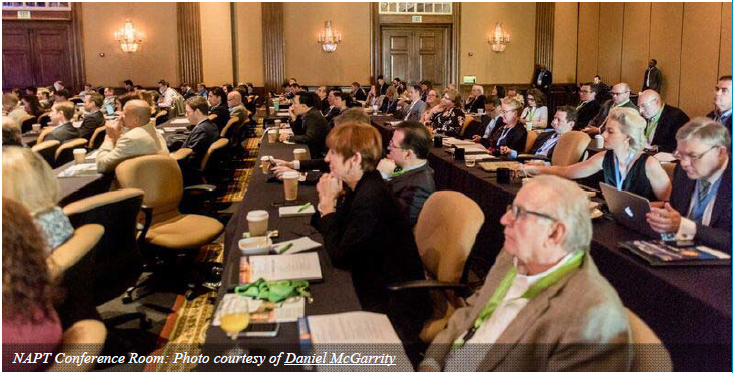
- Healthcare Reform
- Operations
- Reimbursement and Insurance Coverage
- Proton Therapy for Pediatric Patients
- Planning a Proton Therapy Center
What Caught Our Interest
Insurance Coverage
There was much discussion about the challenges of obtaining insurance coverage for proton therapy—not only for prostate cancer, but for other tumor sites as well. The good news is
there is widespread support for stepping up efforts to reverse the trend of non-coverage for proton therapy and there has been success in getting insurance reimbursement for proton for many tumor sites, however the toughest battle we face is still reimbursement for prostate cancer. Here is some of what we learned from the presentations:
- More and more proton centers are cropping up; we’re getting more support from medical directors and administrative staff from these new facilities; and with all the new developments and improvements in the delivery of protons, we’re confident the trend will be reversed and reimbursement efforts will be successful in the future.
- Hypofractionation (shortened treatment protocol) is expected to measurably reduce the cost of proton over time. It may be worth it to focus research and marketing efforts more heavily on HF, which should allow proton therapy access to many more patients.
- Proton therapy is under heavy review. To help patients obtain coverage/overturn denials, we need radiation oncologists to make themselves available for peer-to-peer appeals. This is critical to successful appeals for patients, and also of value to the success and sustainability of proton therapy in general.
- Pediatric applications are demonstrating much more success with reimbursement. Proton therapy has demonstrated great success in minimizing side effects, such as stunting limb growth as well as targeting tumors without doing collateral damage to healthy tissue. Also, the chances of secondary cancers in children later in life are greatly diminished with proton therapy.
- Every successful insurance appeal affects the entire proton community—the more successful the appeals, the stronger we become and more likely to win future appeals.
- The sheer volume of appeals with proton therapy is disproportionately high. There’s pressure on both patients and institutions to just “throw in the towel.” We must resist this and fight for the patient and for our cause.
- Quality letters of medical necessity are critically important in the appeals process. Form letters won’t do. Letters must be custom tailored to each patient in order to increase chances of a successful appeal.
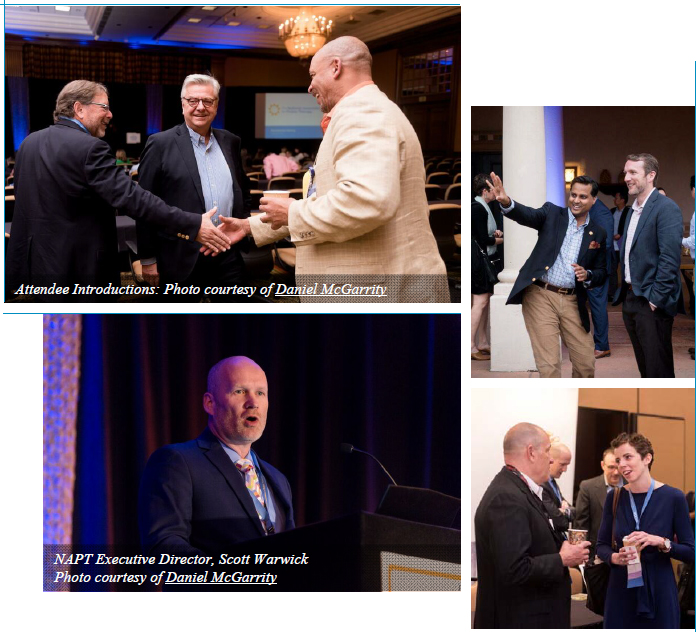
Proton Therapy for Pediatrics
This is a topic Deb was particularly interested in. As a mother of a young child, it’s almost unimaginable to think about your child being diagnosed with cancer. After the initial shock, navigating treatment options is overwhelming, particularly when you think about side effects and secondary cancers that could affect the rest of your child’s life, or perhaps worse, cut his/her life short.
Most tumors in children are treated with surgery, chemotherapy, and traditional radiation therapy. Although these treatments can be effective, they can also induce long-term side effects, such as a decrease in bone and soft tissue growth in the treated area, hormonal deficiencies, intellectual impairment, including neuro-cognitive deficits, and secondary cancers later in life.
Here’s some of what we learned about proton therapy for pediatric patients:
- Pediatric patients typically include infants to age 18.
- Fifteen pediatric diseases are successfully being treated with proton therapy including: medulloblastoma, low- and high-grade gliomas, rhabdomyosarcoma, ewing sarcoma, neuroblastoma, chordoma/chondrosarcoma, and Hodgkin’s lymphoma.
- Eleven proton centers in the U.S. treat more than 1,000 pediatric patients per year and the number is growing rapidly.
- Children from all over the world come to the U.S. to be treated with proton therapy.
- One presenter reported on a recent study that observed secondary malignancies among cancers treated with proton therapy vs. photon radiation (X-rays): The data clearly showed the proportion of patients who developed secondary cancers was consistently lower with proton therapy. This is especially important for children because of their long life expectancy.
- Furthermore, in children with tumors of the brain, IQ is significantly less impacted with proton therapy than with photon radiation. As the brain develops over time, the damage is markedly lower with proton therapy.
- Some proton centers offer specialized services to pediatric patients and their families including opportunities for therapeutic play, journals for recording experience/feelings during treatment, emotional support, special visitors/events and much more.
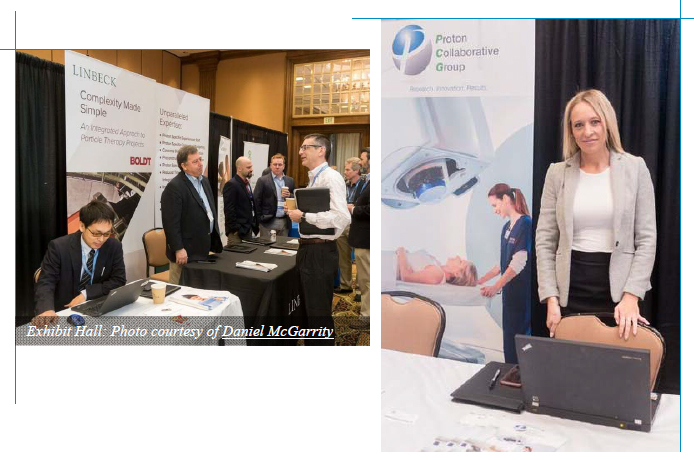
Clinical Trials
Phase I, II, and III clinical trials are critical to effectively treating more disease sites and lowering the cost of proton therapy. Below is an update on a few clinical trials that are under way at Penn Medicine, MD Anderson, Loma Linda University Cancer Center, University of Florida Proton Therapy Institute, and NRG Oncology.
- Penn Medicine is running a clinical trial focusing on breast cancer. Barriers include challenges to accrual, insurance denials, effort required to complete, randomization, and competing studies. Nineteen proton centers are involved.
- MD Anderson is running a clinical trial on esophageal cancer. Evidence shows a significant amount of unnecessary radiation deposited on healthy organs and tissue with IMRT. Results to date show proton improved results in well-matched patients. Further findings:
- When protons are used with surgery, there’s a reduction in hospitalization due to post-operative complications.
- The incidence of pulmonary toxicity is measurably lower for patients treated with protons.
- Overall survival is higher in patients treated with protons.
- Proton therapy improves the dosimetric sparing of the heart and lungs compared to IMRT.
- Other clinical trials in esophageal cancer are under way at Penn Medicine, University of Florida, and Loma Linda University Cancer Center with promising results to date.
- NRG Oncology is doing a Phase III randomized trial comparing overall survival after photon versus proton chemoradation therapy for inoperable non-small cell lung cancer. The trial is just beginning and many proton centers are participating. The biggest challenge so far is patient accrual; and the biggest obstacle to patient accrual is insurance coverage.
- MD Anderson is running another clinical trial comparing IMRT to proton therapy on oropharyngeal cancer of the head and neck. The goal of the trial is to identify a less toxic approach for deliverying conformal radiation therapy to patients and to compare the rates and severity of late grade 3-5 toxicities between IMRT and proton therapy. Early results show unnecessary radiation to healthy tissue is much improved with protons versus other forms of radiation. Nine medical centers are participating in this study.
As we’ve mentioned in previous BOB Tales, the COMPPARE trial is one of the most important initiatives under way in the proton world, as denials by private insurers to cover proton therapy are increasing. This is frustrating patients who are dealing with a cancer diagnosis and must also battle their insurer for coverage.
Dr. Nancy Mendenhall, medical director at the University of Florida Proton Therapy Institute, felt the controversy over proton therapy versus IMRT for prostate cancer would not be fixed without a prospective study. The rationale is that there’s a significant difference in dose distribution between proton- and photon-based plans; reduced entrance dose and no exit dose should lead to reduced toxicity/improvement in quality of life.
Below are some highlights from Dr. Mendenhall’s presentation.
- The data that Dr. Mendenhall presented show a dramatic difference in the amount of radiation deposited on healthy tissue with protons versus IMRT.
- Imaging studies show there’s signifant sparing of most of the rectum with proton beam with a corresponding increase in the dose to the target.
- Patient-reported bowel urgency and frequency are less than half with protons than with IMRT-treated patients.
- Dr. Mendenhall reported significant benefits for proton therapy over IMRT for treating prostate cancer with low-, intermediate-, and high-risk patients.
- The hypothesis of the COMPPARE study is that proton therapy will reduce bowel dysfunction, rectal toxicity interventions, and produce superior disease control in comparison to IMRT.
- It is further hypothesized, as the embedded PARTIQoL study is getting under way, that hypofractionated proton therapy will be as safe and effective as standard fractionated proton therapy.
- In preparation for the COMPPARE study, patient interviews showed the most important results were quality of life, disease control, and survival and that these results are more important than cost and convenience.
- Since fewer than 20 percent of patients are likely to participate in a randomized trial, the study is a non-randomized parallel cohort comparison of results treated with either protons or photons with the same pragmatic protocol (Patients enter the study after they’ve decided to receive proton or photon radiation).
- Patients will be followed for quality of life, toxicity, and freedom from biochemical relapse.
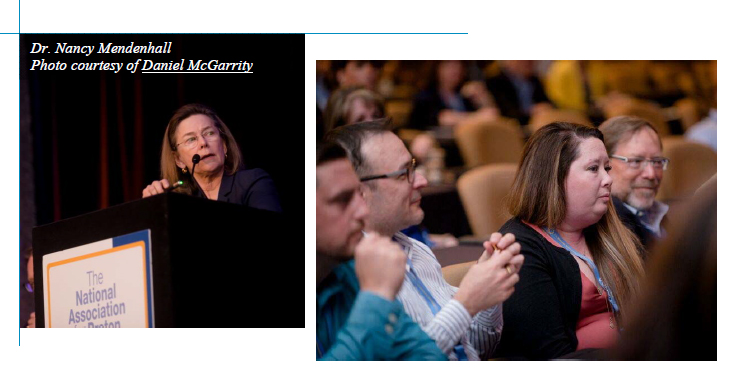
Patient Advocacy Panel
As we mentioned last month, Deb Hickey was honored to be asked by NAPT to be a part of the panel, Advocating for Proton Therapy, as we feel our organization is a perfect fit for the topic.
Below are some highlights from Deb’s presentation.
- She gave a background of the BOB organization and our mission to educate about and promote proton therapy worldwide through a number of vehicles and especially through our 10,000 members.
- Vehicles for spreading awareness and educating others include our website, newsletter, membership, daily email communication, PowerPoint, book, reference lists, Facebook and blog.
- Deb spoke about our key role in introducing patients to the COMPARRE trial comparing protons to IMRT for prostate cancer. We’re expecting that when the trial concludes, it will dramatically change way medical insurance reimburses for proton therapy for prostate cancer.
- It’s important to note that Deb’s jokes about her father, BOB founder, Bob Marckini, were received well by the crowd. If you were at the conference, you have a solid understanding of how Bob meticulously researches any product or service before moving forward with a purchase—from toothpaste to cancer treatment.
- There were three other presenters on the panel: a representative from the Alliance for Proton Therapy, another from the American Cancer Society Cancer Action Network, an advocacy affiliate of the American Cancer Society, and a former proton patient treated at the Mayo Clinic in Phoenix. They spoke about making cancer a top priority by advocating for proton therapy to local media and elected officials so that insurance coverage can more easily be attainable.
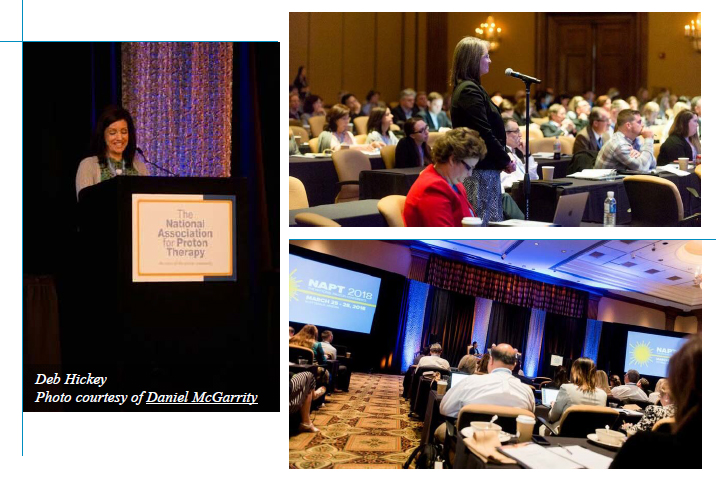
Lifetime Achievement Award Winner
Herman Suit, MD, Msc, D. Phil. is this year’s NAPT Lifetime Achievement Award winner. Suit, founding Chairman of Radiation Oncology at Massachusetts General Hospital, is a pioneer in the field of radiation oncology and proton therapy, having begun his career while the field of radiation oncology was still in its infancy. He also served as a key leader in development of proton therapy. Among his accomplishments are his work with limb-preserving treatment for sarcoma patients and proton treatment for spine, sacral, and skull base tumors.
“Dr. Suit’s work has been invaluable in making proton therapy a medical reality, and we are thrilled to recognize him with this honor,” said Vickie Miller, chairman of the National Association for Proton Therapy. “Cancer patients across the country owe him a debt of gratitude for his vision and pioneering work in the field of radiation oncology.”
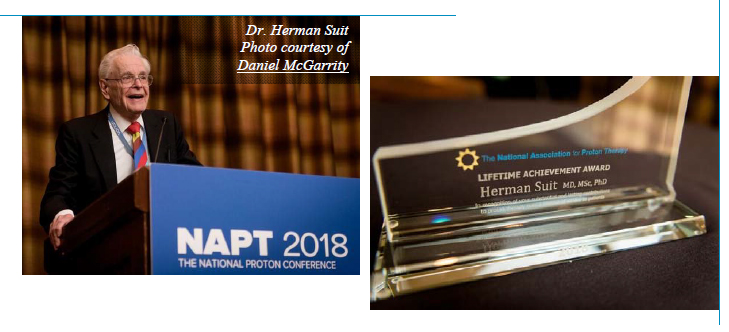
An award ceremony and luncheon was held for Dr. Suit on Thursday during the conference.
“…Being a physician and having an opportunity to treat patients that we can cure, and that couldn’t be cured otherwise without horrendous surgery, is one of the nicest experiences a human being can have,” said Suit.
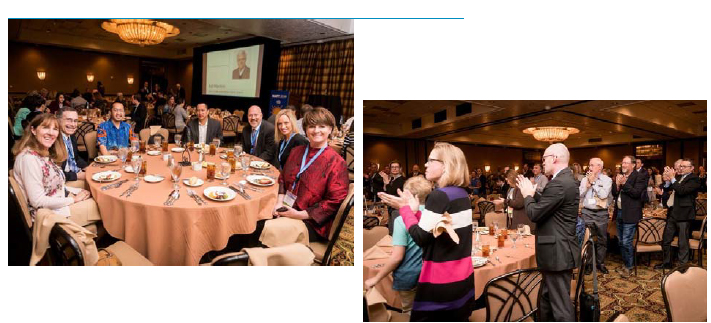
Summary
This recap is just a small sampling of the events at NAPT 2018. Every NAPT conference allows members of the proton community to network, share information, discuss challenges, and build relationships. The take-away from the most recent conference is that the world of proton therapy is still growing rapidly and much progress is being made on all fronts. Proton therapy is no longer a mysterious specialty; it’s just not accepted by all (yet) because it’s expensive. But things are changing: Single-vault options will facilitate expansions; hypofractionation, at a much lower cost, is becoming a viable option for many; clinical studies are illustrating success; patient treatment is more readily available than just five years ago; and more national name brands are supporting proton therapy and building centers across the country and beyond.
The best is yet to come; and after having met some of the best and brightest in the proton world at NAPT 2018, we feel the right people and institutions are going to make it happen.
Until next year …


How to Lower Your Risk of Alzheimer’s
More than five million Americans are living with Alzheimer’s disease, which generally refers to a variety of brain disorders that cause different dementias. By the year 2050 it’s projected that as many as 16 million people will have Alzheimer’s.
Several times a year, we hear from members that they, or their spouses are dealing with dementia or Alzheimer’s disease. Parade Magazine recently ran a feature segment on this subject. Part of the series included recommendations from Richard Isaacson, director of Weill Cornell Medicine’s Alzheimer’s Prevention Clinic. Isaacson is quick to point out that “Some people can do everything right and still get Alzheimer’s.” Nevertheless, for many of us, there are things we can do to minimize the risk:
Know your numbers. Have basic blood tests and know your cholesterol, triglycerides, blood glucose and homocysteine. Know also your blood pressure (hypertension is a key contributor to dementia). Also be aware of your body-mass index and waist circumference. Find ways to bring all these numbers into the proper range.
Take a cognitive test. This is useful to track changes over time. One test you can try at home is the SAGE test.
Hold on to your muscle. We will lose 1 percent of our muscle-mass each year if we do nothing about it. Aerobic and resistance exercise helps to stop or reverse this process.
Maintain a healthy weight.
Eat green, lean, and clean. Brains benefit from a plant-heavy diet which includes veggies,beans, whole grains, nuts and seeds, extra-virgin olive oil, and good protein.
Avoid late-night eating. If not every night, several nights. Twelve to 14 hours of no eating (or at least, no carbs) helps your body burn stored fats.
Put devices to bed. Quality sleep is as important as diet and exercise according to researchers. Try to get at least eight hours every night and avoid the electronics (TV,
iPhone, iPad) that interfere with sleep.
Balance stress with down time. According to Weill Cornell Medicine, every 4.5 years of work stress lead to one additional year of brain aging. Consider yoga, acupuncture, and
regular vacations to combat this.
Keep busy and connected. Hobbies, brain games, and crosswords can challenge the brain. Friends and social contact can protect the brain.
Visit the dentist and eye doctor. Inflammation (gums), hearing loss and anything that interferes with socialization can contribute to dementia.
Take up a musical instrument. Music benefits the brain. Playing and singing, especially, can calm the brain.
Don’t smoke.
Consider genetic testing. Some genes have been linked to Alzheimer’s. Finding these can be a good motivator to take more proactive steps to slow the process.
Join a clinical trial. “The first person cured of Alzheimer’s disease will be in a clinical trial,” says Harvard neurologist Reisa Sperling.
Speaking of clinical trials, this month the largest-ever lifestyle study on preventing cognitive decline will be enrolling participants. This U.S. POINTER study is funded by the Alzheimer’s Association. They are looking for 2,500 symptom-free participants who are at risk for Alzheimer’s, ages 60 to 79. Learn more about the U.S. POINTER study.
We are Facing a “Tick Explosion”
 Dr. Thomas Mather, director of the University of Rhode Island’s tick-borne disease center, warns that this summer will see higher-than-average tick populations throughout the country.
Dr. Thomas Mather, director of the University of Rhode Island’s tick-borne disease center, warns that this summer will see higher-than-average tick populations throughout the country.
Tick populations generally rise in the summer, but numbers this year are expected to be higher than previous seasons due to unique weather patterns. Add to that, while we typically encounter ticks in rural, woody areas, Kayla Socarras, a microbiology researcher at Drexel University College of Medicine in Philadelphia, PA says ticks may be a problem in every region of the United States this season.
Here’s how to protect yourself:
Wear the right clothes. Wear light-colored clothes as bugs tend to blend in with dark colors. Wear long sleeves, pants, and tuck your pants into your socks when in wooded or grassy areas.
Spray yourself. When it’s too hot for long sleeves, use insect repellent. Look for formulas containing DEET, picaridin, or oil of lemon eucalyptus.
Check your body. Check your skin thoroughly for black spots after a trip outside. You should also hop in the shower to wash off—ticks like moist areas, like the groin and under arms.
Don’t assume ticks live only in the woods. Ticks can be found in backyards and city parks. Ticks can easily latch onto birds, mice, and other animals.
Exercise is Not Enough
According to the American Heart Association, and published in Circulation, exercise is not enough to combat the health risks of sitting too much. Adults over 60 spend eight to nine hours a day sitting. This prolonged sedentary time can increase the risk for diabetes, heart disease and death from other causes.
What should you do? Stand or exercise while watching TV; walk around while talking on the phone; stand up or walk around at regular intervals throughout the day.
Another Reason Not to Smoke
 Researchers at the American Cancer Society published the results of a study in the New England Journal of Medicine. The study showed that smoking causes even more diseases and deaths than previously thought.
Researchers at the American Cancer Society published the results of a study in the New England Journal of Medicine. The study showed that smoking causes even more diseases and deaths than previously thought.
In addition to contributing to lung diseases, heart attacks, and stroke, smoking is linked to increased risk for infection, kidney disease, intestinal disease caused by poor blood flow, and some heart and lung diseases. These diseases add 60,000 deaths per year from tobacco in the U.S.
Series: “Make Vegetables Taste Good”
This is the 20th segment on a subject that’s consistent with our Anticancer series. We made it our mission to find recipes that make vegetables and other healthful foods taste delicious. And, we’ve tried them all!
The following recipe proves you don’t need cream for a truly decadent pasta dish. Deb Hickey’s husband made this last week and it was delicious! It was also easy—and only six ingredients.
Note: Nutritional yeast may be hard to find in your local grocery store. It’s available at Whole Foods and other health markets or you can order it on Amazon.
Creamy Vegan Linguine with Wild Mushrooms
Ingredients:
- 1 lb. linguine or fettuccine (We used wheat spaghetti instead.)
- 6 tbsp. olive oil
- 12 oz. mixed mushrooms, thinly sliced
- 3 cloves garlic, finely chopped
- 1/4 c. nutritional yeast
- 2 green onions, thinly sliced on an angle
Directions:
Cook linguine as label directs, reserving 3/4 cups pasta cooking water before draining. Return drained linguine to pot.
Meanwhile, in 12” skillet, heat oil on medium-high. Add mushrooms and garlic; cook 5 minutes or until mushrooms are browned and tender, stirring. Transfer to pot with cooked, drained linguine along with nutritional yeast, reserved cooking water, 1/2 teaspoon salt and 3/4 teaspoon coarsely ground pepper. Toss until well combined. Garnish with green onions.

Reviews! Reviews! Reviews!
 THANK YOU to our recent Amazon book reviewers—mdlee, Gary
THANK YOU to our recent Amazon book reviewers—mdlee, Gary
Corbitt, J.B. Akin, our friend in Florida, gman, Ian Regan, and jpb2! We have over 350 reviews due mostly to you, our members. And we realize we ask (beg?) in every newsletter for those who have found the book helpful to please write (even a one-sentence) review. Why? Reviews are the reason Bob’s book consistently remains in the top five search results on the broad query, “prostate cancer,” and that is crucial to newly diagnosed men and their family members learning abour proton therapy. And reviews are more important than ever as competing books are making their way to the top!
If you haven’t written a review of Bob’s book and you found it helpful to you during the treatment decision making process, please let others know about it by posting a review on Amazon and rating it from one to five stars. Like we’ve said before, Amazon’s search engine algorithm works like this—the more positive reviews, the higher the book’s ranking in the search results. Please post a review today! Click on the gray “Write a Review” button.
Excerpts from recent reviews:

I’ve read Marckini’s book two times …
I am scheduled to start proton beam treatment at Loma Linda. I have read Mr. Marckini’s book two times and I go back often to read important pages … Thank you, Mr. Marckini, for saving me time and tons of effort … Now I know what to do. —mdlee

This book helped me in deciding to choose proton radiation.
This book helped me in decide on proton radiation therapy at the Ackerman Cancer Center in Jacksonville, FL. It is a must read if you’ve been diagnosed with prostate cancer. —Gary Corbitt

I was surprised my urologist was aware of proton radiation and said it was a good option.
… When I met with my urologist and told him my plan of action, I was surprised he was aware of proton radiation and said that was a good option … After reading Bob’s book, there was no reason to look any further [into treatment options]… —J.B. Akin

Five years post proton
Being a gastroenterology nurse, I have seen firsthand the damage radiation can do to the rectum … My husband completed proton therapy at UFPTI in 2013. He had his five-year follow-up colonoscopy two weeks ago and the gastroenterologist saw no signs of radiation proctitis. What a blessing! ... This book is a must-read for patients and their families who have been given this diagnosis.
Buy the book online, in bulk, or in Spanish:
Online: Paperback: $19.00--·--Kindle: $7.99--·--NOOK Book: $9.99--·--Apple iBook: $9.99
In Bulk: Contact us for a discount price list.
In Spanish: Buy the print version or in eBook format.
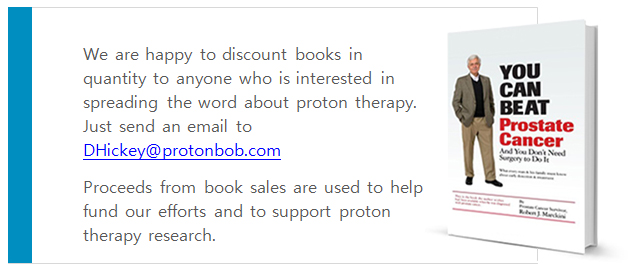
.jpg)
Safest Airline to Fly?
In its 96-year history, Australia’s Qantas Airways has never had a recorded fatality. This was reported from a survey and analysis of records of 425 airlines by aviation-analysis from AirlineRatings.com and reported at MarketWatch.com.
Other top airlines for safety, listed in alphabetical order, are Air New Zealand, Alaska, All Nippon, British Airways, Cathay Pacific, Delta, Japan, KLM, Lufthansa, Scandinavian, Singapore, Swiss, United, and Virgin Atlantic.
The Immortal Pantry
According to Food52.com, some foods in your pantry will last forever! These include sugar, vanilla extract, vinegar, honey, salt and cornstarch.
Estate Planning Hints
BOB Member Ron Hendricks is director of gift planning for Trinity Western University. He regularly copies us on his “News from Ron” mailings, which are helpful hints on estate planning. We’ve found Ron’s suggestions to be timely and beneficial. With his permission we periodically share some of his wisdom with our membership. This segment is called . . .
Putting Together Your Will
Ron was recently asked:
Though it may seem hard to believe, I’ve never gotten around to making a will, but I’d like to now. My question is—do I need to hire a lawyer to write my will, or can I draft it myself?
Fewer than half of American adults have a will, mainly because they haven’t gotten around to it, or they’ve put it off because they don’t want to think about dying.
Having a will is important because it ensures your money and property are distributed to the people and charities you want to receive it after your death. If you die without a will, your estate will be settled in accordance with your law. Details vary by state, but assets typically are distributed using a hierarchy of survivors. Assets go first to a spouse, then to children, then your siblings, and so on.
Do you need a Lawyer?
It’s best to seek professional advice, especially if you have significant financial assets or a complex family situation, like a blended family or a child with special needs. An experienced lawyer can help avoid family confusion and squabbles after you are gone.
Where should I store it?
Once your will is written, the best place to keep it is in a fireproof safe, a file cabinet at home, or in a safe deposit box at your bank. Make sure your executor knows where it is and has access to it. If a professional prepares your will, keep the original document at your lawyer’s office. Also, be sure to update your will if your family or financial circumstances change or if you move to a different state.

Last Month’s Brain Teaser (An easy one?)
A man stands on one side of a river, his dog on the other. The man calls his dog, who immediately crosses the river without getting wet and without using a bridge or a boat. How did the dog do it?
Answer: The river was frozen.
Winner: The May brain teaser winner is Mark Dichter of Hollywood, FL. Mark, a retired general contractor, was diagnosed with prostate cancer in August 2012 at age 66. His urologist recommended IMRT, but he and his wife didn’t feel comfortable going in that direction without first researching other options. While doing his due diligence, Mark found Bob Marckini’s book and decided on proton therapy at the University of Florida Proton Therapy Institute.
“My treatment experience was wonderful,” Mark said. “The only decisions I had to make were where to eat dinner each night.” Since Mark was a candidate for the hypofractionation clinical trial, he volunteered to take part in the shorter treatment protocol. “Five years later, I am cancer free and I’ve had no side effects,” Mark said. He follows up with his doctor at UFPTI every March and will continue to do so as long as necessary for the trial.
Mark enjoys helping newly diagnosed men learn about proton therapy as part of UFPTI’s ambassador program. He also keeps himself busy by fulfilling items on his bucket list. He recently swam with whale sharks in Mexico, attended the royal wedding in London, and visits his kids and 95-year-old grandmother-in-law as often as possible. Mark and his wife, Esther, just celebrated their 50th wedding anniversary.
New Brain Teaser (Not so easy…)
A chauffeur always arrives at the train station at 5 p.m. sharp to pick up his boss and drive him home. One day, the boss arrives an hour early. He starts walking home and is eventually picked up. He’s home 20 minutes earlier than usual. How long did the boss walk before he was picked up by the chauffeur?
Hint: Look at it from the chauffeur’s perspective. And note: all the information you need has been provided.
Send your answer to [email protected] for a chance to win a signed copy of Bob Marckini’s book, You Can Beat Prostate Cancer.
A Second Opinion
Ever since I was a child, I’ve always had a fear of someone under my bed at night. So I went to a therapist and told him, “I’ve got problems. Every time I go to bed I think there’s somebody under it. I’m scared. I think I’m going crazy.”
“Just put yourself in my hands for one year,” said the therapist. “Come talk to me three times a week and we should be able to get rid of those fears.”
“How much do you charge?” I asked.
“One hundred dollars per visit,” replied the therapist.
“I’ll think about it,” I said.
Six months later the therapist met me on the street. “Why didn’t you come to see me about those fears you were having?” he asked.
“Well, 100 bucks a visit, three times a week for a year, is $15,600. A carpenter cured me for 25 bucks. I was so happy to have saved all that money I went and bought a new pick-up truck.”
“Is that so?” With a bit of an attitude he said, “And how, may I ask, did the carpenter cure you?”
“He cut the legs off the bed. Ain’t nobody under there now!”
The moral: It’s always wise to get a second opinion.
Vagaries of the English Language
- Why does the word “funeral” start with “fun?”
- Why isn’t a “fireman” called a “waterman?”
- If money doesn’t grow on trees, how come banks have “branches?”
- If “vegetarians” eat vegetables, what do humanitarians eat?
- How do you get off a “non-stop” flight?
- Why are goods sent by ship called “cargo” and those sent by truck a “shipment?”
- Why do we put “cups” in the “dishwasher” and the “dishes” in the “cupboard”?
- Why is it called “rush hour” when traffic moves at its slowest?
- How come noses “run” and feet “smell”?
- Why do they call it a TV “set” when there’s only one?
Quote of the Month:
“A pessimist sees the difficulty in every opportunity; an optimist sees the opportunity in every difficulty.” — Winston Churchill

An Important Lesson
A young lady confidently walked around the room with a raised glass of water while leading a seminar and explaining stress management to her audience. Everyone knew she was going to ask the obvious question, “Is this glass half empty or half full?”
She fooled them all. “How heavy is this glass of water?” She inquired with a smile. Answers called out ranged from six ounces to one pound.
She replied, “The absolute weight doesn’t matter. It depends on how long I hold it. If I hold it for a minute, that’s not a problem. If I hold it for an hour, I’ll have an ache in my right arm. If I hold it for a day, you’ll have to call an ambulance. In each case, it’s the same weight, but the longer I hold it, the heavier and tougher it becomes.”
She continued, “That’s the way it is with stress. If we carry our burdens all the time, sooner or later, as the burden becomes increasingly heavy, we won’t be able to carry on.”
“As with the glass of water, you have to put it down for a while and rest before holding it again. When we’re refreshed, we can carry on with the burden, handling life’s stressors longer and better each time practiced.”
So, as early in the evening as you can, put all your burdens down. Don’t carry them through the evening and into the night. Pick them up again tomorrow … if you must.
Low PSAs to all!
Bob Marckini and Deb Hickey
NO MEDICAL ADVICE: Material appearing here represents opinions offered by non-medically-trained laypersons. Comments shown here should NEVER be interpreted as specific medical advice and must be used only as background information when consulting with a qualified medical professional.
